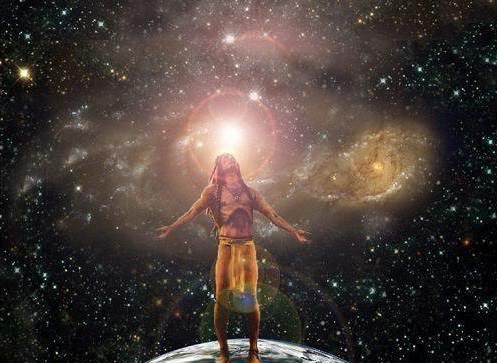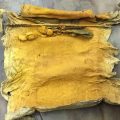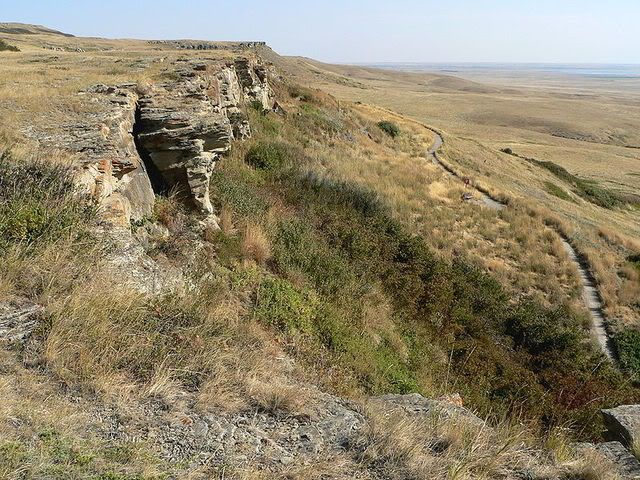
( – promoted by navajo)
Many of the stereotypical images of Indians that abound in movies and popular books were inspired by the Indian nations of the Northern Plains: these are the horse-mounted buffalo hunters that roamed the plains of Montana, Alberta, Saskatchewan, the Dakotas, and Wyoming during the nineteenth century. The popular images of the Northern Plains spirituality often focus on features such as the Sun Dance and the Vision Quest without any understanding of the underlying spiritual principles.
Northern Plains Indian spirituality tended to be somewhat different than the spirituality expressed in Christianity. The Crow warrior Two Leggings said:
“When the Black Robes [Jesuits] came to us they talked about the devil but we could not find him in the things we knew. We think that everything is good and bad and that no person or thing is all good or all bad.”
In the Crow language, the word alachiwakiia/ is often used for religion, but the word translates as “one’s own way” and may interpreted as “it’s up to you!” The experiences and manifestations of the power that enables life are personal.
Spirituality among the Northern Plains tribes was traditionally very personal. There was generally no universally acknowledged set of dogmas. Nor was there any ecclesiastical organization that handed down laws for the guidance of the religious consciousness. No one insisted that a person should believe in a particular creation myth or subscribe to some accepted concept of the hereafter.
As with tribes in other culture areas, the Indian nations of the Northern Plains did not traditionally separate their spiritual life from their daily life. The natural world and the supernatural world were not seen as distinct entities but as integrated into the people’s view of the universe. All things are alive-and therefore usually spoken of as “people.” This includes the animal-people, the plant-people, and forces such as streams, thunder, wind, sun, rocks, and so on.
Throughout their lives, the Indian people of the Northern Plains would carry on a dialogue with spiritual patrons who would guide their daily decisions through instructions given in dreams. In addition, these spiritual patrons could be summoned with special talismans (often included in their medicine bundles) and songs when danger was near or when help was needed in curing or in finding buffalo.
The term “medicine man” and “medicine woman” are usually used today to indicate a person who has some special spiritual power. Traditionally, these people treated the sick, conducted ceremonies, and spoke of the future. These medicine people were taught by supernatural entities or spirits who appeared to them in dreams or visions. These visits were often prompted by a prolonged fast and by the many sacrifices made to the spirits. There were many ways of practicing these healing powers and therefore each man and woman conducted ceremonies differently and according to the way they had been instructed in their visions.
There are many important elements which define the traditional spirituality of the Northern Plains Indians. These elements include the sacred pipe, the sweat lodge, smudging, and paint.
The Sacred Pipe:
Smoking the pipe is a way of making prayers and communications to the spirits visible. The pipe is incorporated into almost all Plains Indian ceremonials. Some pipes are owned or held by individuals, while others are a part of societal or tribal bundles. The pipe symbolized peaceful intent, truthfulness, and mutual obligation.
Some of the Northern Plains tribes had tribal pipes, pipes which were used to spiritually aid the tribe. Among the Arapaho, for example, their Flat Pipe was viewed as a sacred object which was held in the highest respect. The keeper of the Flat Pipe was responsible for the care of the pipe and for praying daily for the well-being of the tribe. The keeper also assisted individuals who had vowed to pray through personal sacrifice to the pipe.
White Buffalo Woman gave the sacred pipe to the Lakota with precise instructions on how to use the pipe as an agent of prayer and peace. She told the Lakota that those who fought each other within the tribe must be friends.
While most of the northern Plains tribes used stone pipes with a T-shaped stone bowl, the Crow most frequently used straight tubular stone bowls. Among the Mandan, the village Medicine Pipe was crafted out of clay with a large center bowl and four pipe stems. It allows four medicine people to smoke together.
The Sweat Lodge:
The sweat lodge is the oldest known ritual among the Northern Plains tribes. It precedes most religious ceremonies and is often conducted as a ceremony in its own right. In ceremonial context, the sweat lodge functions to purify the participants.
Smudging:
The smoke of sage, sweetgrass, and other plants is often used for purification. Smudging makes it possible to see and communicate directly with the spirits. Smudging is a part of almost all spiritual activities. Among many of the tribes, smudging with sweetgrass (Savastana odorata) is a universal component for all ceremonies. The smoke is a purifying agent, a means of dispelling the everyday atmosphere and substituting a pleasant odor for the spirits.
Paint:
While non-Indians sometimes call the Indian use of paint as “war paint”, the painting of the body, face, and hands is an important part of many ceremonies which are not related to war. According to Blackfoot elder Long Standing Bear Chief:
“We believe that the Creator gave paint as one of four gifts to the human child of this Great Holy Being. Paint was given to use as a means of painting a person in difficulty because they were being marked for special recognition as being a person of the Source of Life’s making.”
Among the Gros Ventre, people have traditionally painted their faces with a special design in red paint. This symbolizes creation and their special relationship with the Great Mystery.



Leave a Reply